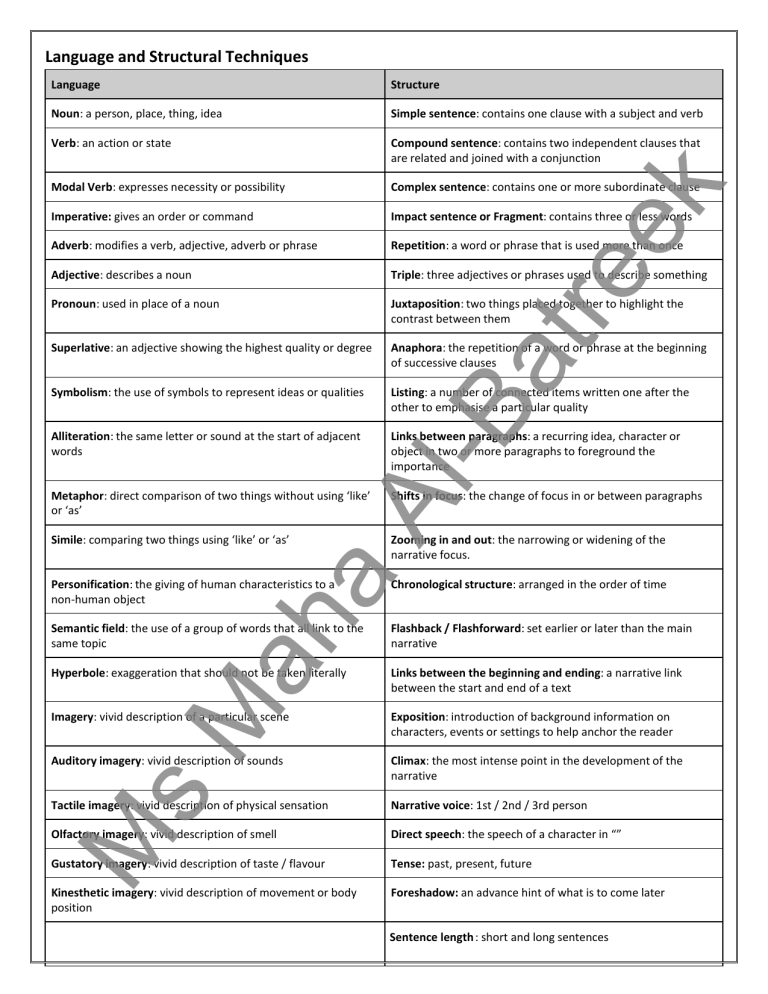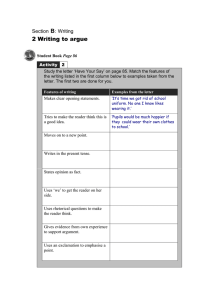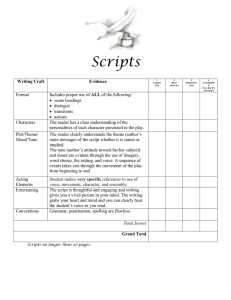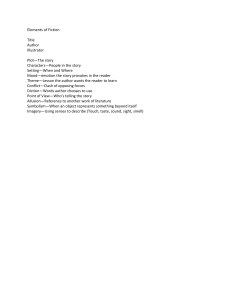
Language and Structural Techniques Structure Noun: a person, place, thing, idea Simple sentence: contains one clause with a subject and verb Verb: an action or state Compound sentence: contains two independent clauses that are related and joined with a conjunction Modal Verb: expresses necessity or possibility Complex sentence: contains one or more subordinate clause Imperative: gives an order or command Impact sentence or Fragment: contains three or less words Adverb: modifies a verb, adjective, adverb or phrase Repetition: a word or phrase that is used more than once Adjective: describes a noun Triple: three adjectives or phrases used to describe something Pronoun: used in place of a noun Juxtaposition: two things placed together to highlight the contrast between them Superlative: an adjective showing the highest quality or degree Anaphora: the repetition of a word or phrase at the beginning of successive clauses Symbolism: the use of symbols to represent ideas or qualities Listing: a number of connected items written one after the other to emphasise a particular quality Alliteration: the same letter or sound at the start of adjacent words Links between paragraphs: a recurring idea, character or object in two or more paragraphs to foreground the importance Al -B at re ek Language Shifts in focus: the change of focus in or between paragraphs Simile: comparing two things using ‘like’ or ‘as’ Zooming in and out: the narrowing or widening of the narrative focus. ah a Metaphor: direct comparison of two things without using ‘like’ or ‘as’ Chronological structure: arranged in the order of time Semantic field: the use of a group of words that all link to the same topic Flashback / Flashforward: set earlier or later than the main narrative Hyperbole: exaggeration that should not be taken literally Links between the beginning and ending: a narrative link between the start and end of a text M Personification: the giving of human characteristics to a non-human object Exposition: introduction of background information on characters, events or settings to help anchor the reader Auditory imagery: vivid description of sounds Climax: the most intense point in the development of the narrative s Imagery: vivid description of a particular scene Narrative voice: 1st / 2nd / 3rd person Olfactory imagery: vivid description of smell Direct speech: the speech of a character in “” Gustatory imagery: vivid description of taste / flavour Tense: past, present, future Kinesthetic imagery: vivid description of movement or body position Foreshadow: an advance hint of what is to come later M Tactile imagery: vivid description of physical sensation Sentence length : short and long sentences M s at re -B Al ah a M The writer I author... builds... develops... contrasts... intensifies... reinforces... highlights... foregrounds... isolates... layers... begins... maintains... juxtaposes... sequences... shifts... introduces... emphasises... constructs... organises... guides ... anchors ... ek Useful phrases when discussing structural techniques: What Does Tone Mean in Literature? ek In literary terms, tone typically refers to the mood implied by an author's word choice and the way that the text can make a reader feel. The tone an author uses in a piece of writing can evoke any number of emotions and perspectives. What are some examples of tone? M s M ah a Al -B The effect of the tone changes according to the feeling. at re The tone in a story indicates a particular feeling. It can be joyful, serious, humorous, sad, threatening, formal, informal, dry, pessimistic, optimistic, lighthearted, cheerful, assertive, nostalgic, regretful. s M ah a M Al at re -B ek s M ah a M Al at re -B ek Informal Language Features and Their Effects Feature+ example+ effect Al Structural Features -B at re ek Exclamation of ‘Sounds good to me!’ is very personal and informal. Use of ‘(which let’s face it, we all do)’ in brackets uses a contraction and also links the writer very informally to the reader. ‘Imagine the fun you could have . . . ’ is informal, as the sentence is unfinished Use of dashes to insert ‘– and to be honest, it sounds awful –’ gives a personal commentary/opinion. Use of the dash in ‘ – no need to eat’ is humorous. Use of a rhetorical question, ‘How boring would that be?’, is very chatty and creates strong links between the writer and the reader. non-standard English-misspelled words abbreviations empathy and emotion M s M ah a long, complex sentence to give more details use of a question short/minor sentence single sentence paragraph one-word sentence paragraph repetition triple contrast listing/rule of three tenses Article Features: -B Formal/Informal Article Features: at re ek Headings subheadings lead byline quotations references to dates referring to writers / books / articles ending each section with an accuracy rating Al The type of language a writer uses is linked to the audience and purpose of a text. For example, a headteacher writing to parents about school rules will use formal language to indicate their professional status, their respect for their relationship with their audience and also the seriousness of the topic. Formal language choices include the use of: ah a • complex words, such as specialist terms or more elevated synonyms • punctuation such as colons and semi-colons • complex sentence structures. M Writers sometimes use informal language to talk to their reader in a friendly way, which establishes a relationship between writer and reader. For example, a text encouraging children to start cycling will be written in a way that is lighthearted and easy to read. Informal language choices include the use of: s • simpler vocabulary and contractions • punctuation such as exclamation marks and dashes • simple and compound sentences. M Punctuation Marks and Their Effects: ek There are times when punctuation choices can help to create diffserent effects. Punctuation such as brackets, dashes and exclamation marks are not only ways of organising information in a sentence, they also communicate levels of formality and different shades of meaning. Look at these examples and explanations. at re • I went for a walk, even though it was getting late, and found myself lost in a maze of streets. The commas give this a formal feel and a calm, explanatory tone. • I went for a walk (even though it was getting late) and found myself lost in a maze of streets. -B The brackets still give this statement a formal feel, but they create the impression of an aside – as if the narrator is involving the reader in their thoughts a little more. Al • I went for a walk – even though it was getting late – and found myself lost in a maze of streets. This example is less formal and more conversational. The dashes make it appear closer to spoken English, as if the narrator is casually (maybe quickly) explaining the situation. ah a • I went for a walk – even though it was getting late – and found myself lost in a maze of streets! This example sounds more dramatic. The exclamation mark suggests heightened emotion, as if the narrator is scared or excited. M The choice of punctuation can help the reader to interpret the meaning of a sentence. Notice how the addition of the exclamation mark creates a different meaning to the version containing only commas. s -Ellipses are also used in a sentence to show hesitation, suspense, or a change of mood. M The main purpose of contrast is to underline ideas and explain their meanings, so readers can easily follow a story or argument. Through opposite and contrasting ideas, writers make their arguments stronger, which makes them more memorable for readers due to emphasis placed on them. What makes an article’s opening effective? Some examples of these are: at re -B Emotive Words Examples: ek relevant facts statistics rhetorical questions directly addressing the reader emotive language short sentences quotations anecdotes hyperbole Al ah a Adjectives - appalling, wonderful, heavenly, magical and tragic. Abstract Nouns - freedom, pride, justice, love, fear and terror. Verbs - destroyed, vindicated, saved, betrayed and adored M s M Adverbs - angrily, defiantly, proudly, and beautifully.






